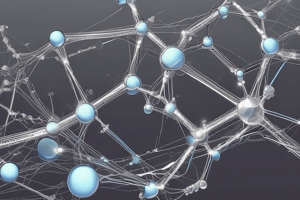Podcast
Questions and Answers
What type of molecular movement involves the movement of molecules from one place to another?
What type of molecular movement involves the movement of molecules from one place to another?
Translational motion
What is the main factor that increases molecular movement and kinetic energy?
What is the main factor that increases molecular movement and kinetic energy?
Temperature
What is the random movement of particles suspended in a fluid due to collisions with surrounding molecules?
What is the random movement of particles suspended in a fluid due to collisions with surrounding molecules?
Brownian motion
What is the process of spontaneous mixing of molecules from an area of higher concentration to an area of lower concentration?
What is the process of spontaneous mixing of molecules from an area of higher concentration to an area of lower concentration?
Why is molecular movement important for heat transfer between systems?
Why is molecular movement important for heat transfer between systems?
What is the role of molecular movement in chemical reactions?
What is the role of molecular movement in chemical reactions?
Which type of molecular movement involves the rotation of molecules around a fixed axis?
Which type of molecular movement involves the rotation of molecules around a fixed axis?
Flashcards are hidden until you start studying
Study Notes
Types of Molecular Movement
There are three main types of molecular movement:
- Translational motion: Movement of molecules from one place to another.
- Rotational motion: Rotation of molecules around a fixed axis.
- Vibrational motion: Vibrations of molecules about their mean position.
Factors Affecting Molecular Movement
- Temperature: Increases molecular movement and kinetic energy.
- Surface area: Larger surface area increases molecular movement.
- Concentration: Higher concentration of molecules increases movement.
- Particle size: Smaller particles move more quickly than larger ones.
Random Motion of Molecules
- Brownian motion: Random movement of particles suspended in a fluid due to collisions with surrounding molecules.
- Diffusion: Spontaneous mixing of molecules from an area of higher concentration to an area of lower concentration.
Importance of Molecular Movement
- Heat transfer: Molecular movement facilitates heat transfer between systems.
- Mass transport: Molecular movement enables mass transport across cell membranes and in chemical reactions.
- Chemical reactions: Molecular movement increases the likelihood of collisions, facilitating chemical reactions.
Types of Molecular Movement
- Translational motion involves the movement of molecules from one place to another.
- Rotational motion involves the rotation of molecules around a fixed axis.
- Vibrational motion involves the vibrations of molecules about their mean position.
Factors Affecting Molecular Movement
- Temperature increases molecular movement and kinetic energy.
- A larger surface area increases molecular movement.
- A higher concentration of molecules increases movement.
- Smaller particles move more quickly than larger ones.
Molecular Movement Concepts
- Brownian motion is the random movement of particles suspended in a fluid due to collisions with surrounding molecules.
- Diffusion is the spontaneous mixing of molecules from an area of higher concentration to an area of lower concentration.
Importance of Molecular Movement
- Molecular movement facilitates heat transfer between systems.
- Molecular movement enables mass transport across cell membranes and in chemical reactions.
- Molecular movement increases the likelihood of collisions, facilitating chemical reactions.
Studying That Suits You
Use AI to generate personalized quizzes and flashcards to suit your learning preferences.




